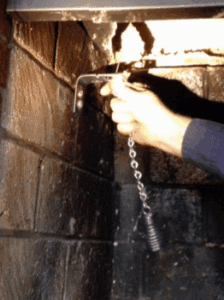 Of all the working components of your fireplace, you are probably most familiar with your damper. You open the damper each time you light a fire to allow smoke to escape, and you close the damper once your fire has gone out to keep your home’s warm air from rising out of your chimney. But are you sure you damper is working?
Of all the working components of your fireplace, you are probably most familiar with your damper. You open the damper each time you light a fire to allow smoke to escape, and you close the damper once your fire has gone out to keep your home’s warm air from rising out of your chimney. But are you sure you damper is working?
How dampers fail
Nearly all dampers are metal on metal construction. When you close the damper, a metal flap closes into place against a metal gasket. Originally, that flap and gasket will form a relatively tight seal. Over time, however, dampers are prone to warping, either from the extreme heat of your fireplace or from moisture or water that’s finding its way into your chimney.
Why a failing damper matters
We all know that warm air rises. That means that when your fireplace isn’t in use and your damper isn’t sealing off the chimney, the warm air from your home will rise up and out of your chimney. In fact, up to 8 percent of a home’s heat can be lost through the chimney when the damper isn’t properly in place. Your faulty damper could be costing you a significant amount of money in home-heating costs!
How to tell if your damper is working
The most obvious sign of a failing damper is a draft coming through your fireplace when the damper is in the closed position. If you’re feeling a draft coming from your chimney, there are a few ways you can further explore the condition of your damper. Most simply, you might be able to get a good look at your damper by shining a flashlight up the chimney. If you can’t tell how well your damper is sealing, you also can ignite a few tightly rolled pieces of newspaper in the fireplace with the damper in the closed position. If the smoke makes its way into the chimney even though the damper is in the closed position, that’s a clear sign your damper isn’t working.
What to do about a failing damper
Obviously, you will want to deal with your failing damper to make sure that your chimney isn’t being a drain on your home-heating bill! When an old throat damper fails, most chimney experts will recommend replacing the damper with a top-sealing chimney damper. Top-sealing, or top-down, dampers are installed at the very top of your chimney’s flue. When closed, they form a tight seal that prevents hot air from escaping through the chimney. Because they close firmly, top-sealing dampers have the added advantages of protecting your chimney from precipitation, strong drafts, animals and debris.
If you suspect that your damper is failing, call Environmental Chimney Service today! We can inspect your damper, and if it is no longer sealing and doing its job to keep warm air in your home, we can help you find the best solution to keep your home’s warm air from escaping through the chimney.
